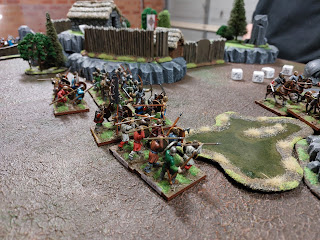This week's games saw a belated beginning to Frostgrave - a game I have looked longingly at for some time. My good friend, Nick, and I embarked on a first game. We played a basic game rather than a scenario and tried to grab as many of the 5 treasure tokens as we could.
Nick has been busy printing, purchasing and painting a range of terrain suitable for fantasy skirmish. I mixed in a little of my own considerable collection. Nick's use of Renedra fences as walkways worked very well and I think they look better than my coffee stirrer and match stick scratch builds.
I used a witch with a mix of movement and blocking spells (like mud and fog) with some spells to bolster my minions too. To represent these forces I used my Splintered Fang. Nick used his 3D printed Dwarfs to represent his warband led by a sigilist. He also chose many manipulative rather than directly offensive spells.
I began by leaping my man-at-arms forward to block a treasure token on Nick's side of the table then ran forward to secure it with my treasure hunter. In the meantime, I used by thugs and thieves to secure objectives on my side (within the watch tower below). Also a ran my crusader forward to fend off any attacks on the central treasure token.
Above shows my strategy to protect my men and slow the Dwarf advance by channeling my witch apprentice powers to turn the earth to mud. I would later shield this side of the table further with a wall of fog.
Nick's Dwarfs pass the 'Tree of Woe' and rush forward. My man-at-arms is just visible ready to fend off assault while my other men run off with the treasure.
Nick was able to open a hole in a stone wall to allow a soldier to clamber through and prevent my escape with a treasure token. This was, not the first, but a tangible sign of impending doom for my witch's cult. A mass of 1's rolled - probably more than 12 on the night - sapping my strength through spell failure and leading to disastrous combat results. My men regularly took 5, 6 or even 7 hits in combat. I lost two treasure tokens I had taken control over - one to a well used Fool's Gold spell (very Dwarfy spell I must add) - and barely got another two to the board edge.
However, due to repeated combat losses, all of my men had many wounds and were locked in combat that they just couldn't escape from. I wasn't winning and Nick simply held me in combat by refusing to push me back. He just held me there as I lost fight after fight.
And then ... monsters came on. Directly in my path of escape 2 armoured skeletons marched. Again, I lost many fights and my wizards failed spells to bolster strength. By now my wizard had but 4 health left and my apprentice but 1. While the young witch escaped, the witch was shot then hacked down.
All evening, I think I won two combats ... and one was against a skeleton. With my wizard dead my warband collapsed at the end of the first game. Not a good start.
I really did enjoy the game despite my sheer inability to win any combat at all or profit from the really good positions I had gained in the early game. I was a total disaster really. Many soldiers died or were wounded too. The rules seems very good although I must say being helplessly locked in combat once engagement had occurred did - and does - seem quite restrictive. Just running in and pinning the enemy - and keep pinning them (without even fighting) if initiative is won - seems a bit easy to achieve in an otherwise very thoughtful game. Some sort of mechanic to leave combat, even at a risk, would be a good addition by providing an additional decision for players to make.






































